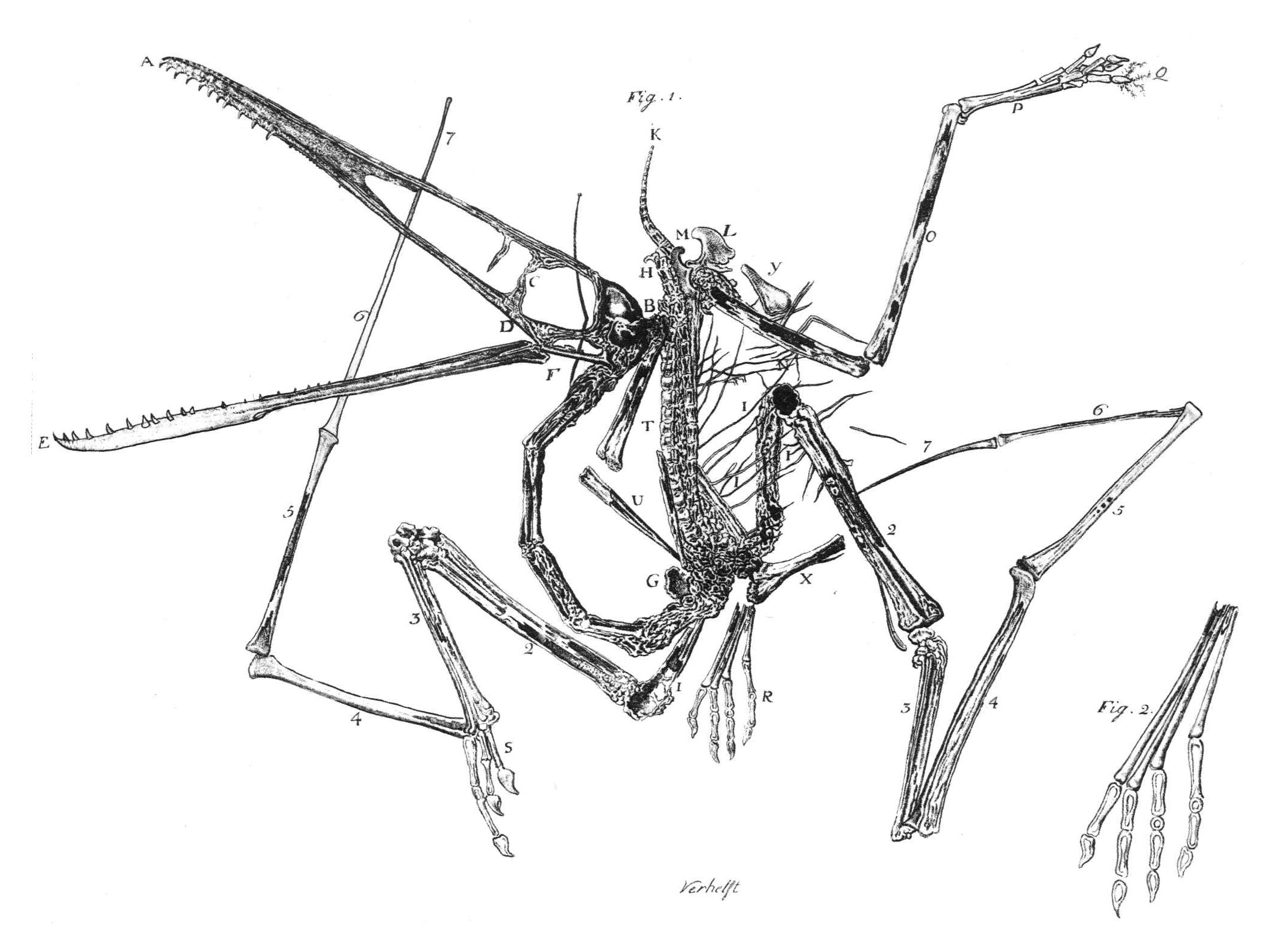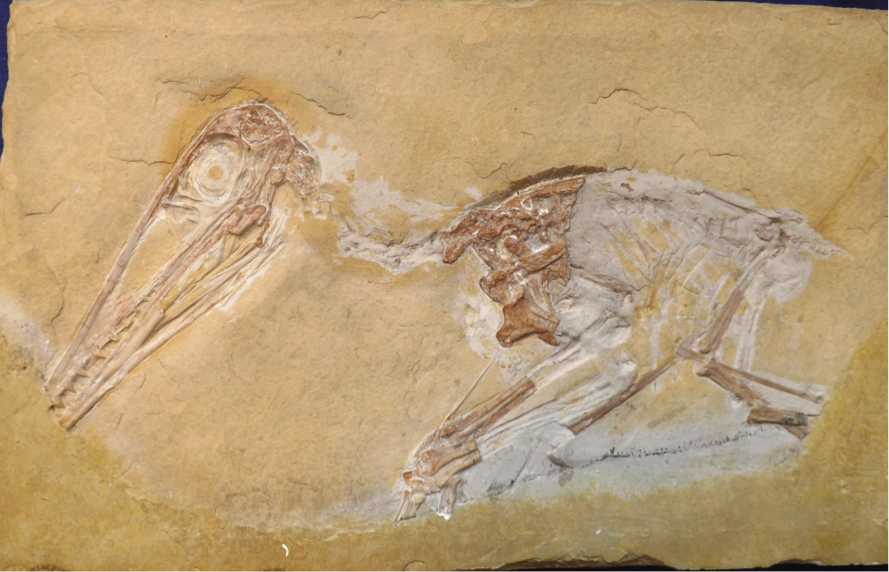|
Ardeadactylus
''Ardeadactylus'' (from ''Ardea'' – meaning "heron", and also a name of a genus of herons – and ''dactylus'', meaning "finger") is an extinct genus of ctenochasmatoid pterosaur known from the Late Jurassic Solnhofen limestone of Bavaria, southern Germany. It contains a single species, ''Ardeadactylus longicollum'', which was originally thought to be a species of ''Pterodactylus'', as ''P. longicollum''. History Only two specimens of ''Ardeadactylus'' are known to exist currently: SMNS 56603 (earlier SMNS 5802) found in 1874, a specimen from Nusplingen initially thought to belong to the species ''Pterodactylus suevicus'' (currently ''Cycnorhamphus''), and the neotype of the species, JME-SOS 2428, a specimen held at Jura Museum in Eichstätt. Other known specimens, including the holotype designated by Christian Erich Hermann von Meyer when he named the type species ''Pterodactylus longicollum'' in 1854,Meyer, C.E.H. von, 1854, "Mittheilungen an Professor Bronn: Anthracotheri ... [...More Info...] [...Related Items...] OR: [Wikipedia] [Google] [Baidu] |
Ardeadactylus Longicollum Holotype
''Ardeadactylus'' (from ''Ardea'' – meaning "heron", and also a name of a genus of herons – and ''dactylus'', meaning "finger") is an extinct genus of ctenochasmatoid pterosaur known from the Late Jurassic Solnhofen limestone of Bavaria, southern Germany. It contains a single species, ''Ardeadactylus longicollum'', which was originally thought to be a species of '' Pterodactylus'', as ''P. longicollum''. History Only two specimens of ''Ardeadactylus'' are known to exist currently: SMNS 56603 (earlier SMNS 5802) found in 1874, a specimen from Nusplingen initially thought to belong to the species '' Pterodactylus suevicus'' (currently ''Cycnorhamphus''), and the neotype of the species, JME-SOS 2428, a specimen held at Jura Museum in Eichstätt. Other known specimens, including the holotype designated by Christian Erich Hermann von Meyer when he named the type species ''Pterodactylus longicollum'' in 1854,Meyer, C.E.H. von, 1854, "Mittheilungen an Professor Bronn: Anthracoth ... [...More Info...] [...Related Items...] OR: [Wikipedia] [Google] [Baidu] |
Pterodactylus
''Pterodactylus'' (from Greek () meaning 'winged finger') is an extinct genus of pterosaurs. It is thought to contain only a single species, ''Pterodactylus antiquus'', which was the first pterosaur to be named and identified as a flying reptile. Fossil remains of ''Pterodactylus'' have primarily been found in the Solnhofen limestone of Bavaria, Germany, which dates from the Late Jurassic period (early Tithonian stage), about 150.8 to 148.5 million years ago. More fragmentary remains of ''Pterodactylus'' have tentatively been identified from elsewhere in Europe and in Africa. ''Pterodactylus'' was a generalist carnivore that probably fed on a variety of invertebrates and vertebrates. Like all pterosaurs, ''Pterodactylus'' had wings formed by a skin and muscle membrane stretching from its elongated fourth finger to its hind limbs. It was supported internally by collagen fibres and externally by keratinous ridges. ''Pterodactylus'' was a small pterosaur compared to other fam ... [...More Info...] [...Related Items...] OR: [Wikipedia] [Google] [Baidu] |
Ctenochasmatoid
Ctenochasmatoidea is a group of early pterosaurs within the suborder Pterodactyloidea. Their remains are usually found in what were once coastal or lake environments. They generally had long wings, long necks, and highly specialized teeth. Evolutionary history The earliest known ctenochasmatoid remains date to the Late Jurassic Kimmeridgian age. Previously, a fossil jaw recovered from the Middle Jurassic Stonesfield Slate formation in the United Kingdom, was considered the oldest known. This specimen supposedly represented a member of the family Ctenochasmatidae,Buffetaut, E. and Jeffrey, P. (2012). "A ctenochasmatid pterosaur from the Stonesfield Slate (Bathonian, Middle Jurassic) of Oxfordshire, England." ''Geological Magazine'', (advance online publication) though further examination suggested it belonged to a teleosaurid stem-crocodilian instead of a pterosaur. Ecology Most ctenochasmatoids were aquatic or semi-aquatic pterosaurs, possessing large webbed hindfeet and long to ... [...More Info...] [...Related Items...] OR: [Wikipedia] [Google] [Baidu] |
Diopecephalus
''Diopecephalus'' is a genus of pterodactyloid pterosaur from the Lower Tithonian (Upper Jurassic) of the Lithographic Limestone, Bavaria, Germany. The type and only species is ''D. kochi'', although the name has been applied to ''Pterodactylus longicollum'', with ''longicollum'' erroneously listed as the type species. Assigned species Like many pterosaurs, it has had a confusing taxonomic history, being given names by various authorities which identify it with four other genera: *''Pterodactylus longicollum'' (von Meyer 1854) *''Pterodactylus vulturinus'' (Wagner 1857) *''Pterodactylus longicollis'' (Wagner 1858) *''Pterodactylus suevicus'' (Fraas 1878) *''Cycnorhamphus fraasii'' (Seeley 1891) *''Pterodactylus frassi'' (Seeley 1901) *'' Gallodactylus longicollum'' (Fabre 1974) *''Ornithocephalus longipes'' (Olshevsky 1978) (''Ornithocephalus'' is an obsolete name for ''Pterodactylus'') *''Ornithocephalus vulturinus'' (Olshevsky 1978) In 2017, Steven U. Vidovic and David M. Mar ... [...More Info...] [...Related Items...] OR: [Wikipedia] [Google] [Baidu] |
Peter Wellnhofer
Peter Wellnhofer (born Munich, 1936) is a German paleontologist at the Bayerische Staatssammlung fur Paläontologie in Munich. He is best known for his work on the various fossil specimens of ''Archaeopteryx'' or "Urvogel", the first known bird. Wellnhofer's other work includes ''The Illustrated Encyclopedia of Pterosaurs'' from 1991. '' Wellnhoferia'', a bird closely related to ''Archaeopteryx'', or a species of the Urvogel itself, was named in his honour in 2001. The pterosaur ''Wellnhopterus'' was named in his honour in 2021. In 2007 a special meeting of pterosaur experts in Munich was dedicated to Wellnhofer, describing him as "the foremost authority on pterosaurs for the last four decades." The meeting produced a festschrift In academia, a ''Festschrift'' (; plural, ''Festschriften'' ) is a book honoring a respected person, especially an academic, and presented during their lifetime. It generally takes the form of an edited volume, containing contributions from the ... i ... [...More Info...] [...Related Items...] OR: [Wikipedia] [Google] [Baidu] |
Ludwig Frischmann
Ludwig may refer to: People and fictional characters * Ludwig (given name), including a list of people and fictional characters * Ludwig (surname), including a list of people * Ludwig Ahgren, or simply Ludwig, American YouTube live streamer and content creator Arts and entertainment * ''Ludwig'' (cartoon), a 1977 animated children's series * ''Ludwig'' (film), a 1973 film by Luchino Visconti about Ludwig II of Bavaria * '' Ludwig: Requiem for a Virgin King'', a 1972 film by Hans-Jürgen Syberberg about Ludwig II of Bavaria * "Ludwig", a 1967 song by Al Hirt Other uses * Ludwig (crater), a small lunar impact crater just beyond the eastern limb of the Moon * Ludwig, Missouri, an unincorporated community in the United States * Ludwig Canal, an abandoned canal in southern Germany * Ludwig Drums, an American manufacturer of musical instruments * ''Ludwig'' (ship), a steamer that sank in 1861 after a collision with the '' Stadt Zürich'' See also * Ludewig * Ludvig * Ludwik * Ludwic ... [...More Info...] [...Related Items...] OR: [Wikipedia] [Google] [Baidu] |
World War II
World War II or the Second World War, often abbreviated as WWII or WW2, was a world war that lasted from 1939 to 1945. It involved the World War II by country, vast majority of the world's countries—including all of the great powers—forming two opposing military alliances: the Allies of World War II, Allies and the Axis powers. World War II was a total war that directly involved more than 100 million Military personnel, personnel from more than 30 countries. The major participants in the war threw their entire economic, industrial, and scientific capabilities behind the war effort, blurring the distinction between civilian and military resources. Air warfare of World War II, Aircraft played a major role in the conflict, enabling the strategic bombing of population centres and deploying the Atomic bombings of Hiroshima and Nagasaki, only two nuclear weapons ever used in war. World War II was by far the List of wars by death toll, deadliest conflict in hu ... [...More Info...] [...Related Items...] OR: [Wikipedia] [Google] [Baidu] |
Type Species
In zoological nomenclature, a type species (''species typica'') is the species name with which the name of a genus or subgenus is considered to be permanently taxonomically associated, i.e., the species that contains the biological type specimen(s). Article 67.1 A similar concept is used for suprageneric groups and called a type genus. In botanical nomenclature, these terms have no formal standing under the code of nomenclature, but are sometimes borrowed from zoological nomenclature. In botany, the type of a genus name is a specimen (or, rarely, an illustration) which is also the type of a species name. The species name that has that type can also be referred to as the type of the genus name. Names of genus and family ranks, the various subdivisions of those ranks, and some higher-rank names based on genus names, have such types. [...More Info...] [...Related Items...] OR: [Wikipedia] [Google] [Baidu] |
Holotype
A holotype is a single physical example (or illustration) of an organism, known to have been used when the species (or lower-ranked taxon) was formally described. It is either the single such physical example (or illustration) or one of several examples, but explicitly designated as the holotype. Under the International Code of Zoological Nomenclature (ICZN), a holotype is one of several kinds of name-bearing types. In the International Code of Nomenclature for algae, fungi, and plants (ICN) and ICZN, the definitions of types are similar in intent but not identical in terminology or underlying concept. For example, the holotype for the butterfly '' Plebejus idas longinus'' is a preserved specimen of that subspecies, held by the Museum of Comparative Zoology at Harvard University. In botany, an isotype is a duplicate of the holotype, where holotype and isotypes are often pieces from the same individual plant or samples from the same gathering. A holotype is not necessaril ... [...More Info...] [...Related Items...] OR: [Wikipedia] [Google] [Baidu] |
Eichstätt
Eichstätt () is a town in the federal state of Bavaria, Germany, and capital of the district of Eichstätt. It is located on the Altmühl river and has a population of around 13,000. Eichstätt is also the seat of the Roman Catholic Diocese of Eichstätt. Geography Location Eichstätt lies on both sides of the river Altmühl in the district of Eichstätt of the Oberbayern region of Bavaria, in the heart of Altmühl Valley Nature Park. Geology Eichstätt is located in a valley of the Franconian Jura and is famous for the quarries of Solnhofen Plattenkalk (Jurassic limestone). On the Blumenberg the Berlin specimen of Archaeopteryx was found by Jakob Niemeyer. History St. Willibald founded the Diocese of Eichstätt on the site of an old Roman station ( or ) in 741. The city was given walls and chartered in 908. It was ruled by a prince-bishop, and in the Holy Roman Empire was the seat of the Bishopric of Eichstätt until secularization in 1802. In 1806, it beca ... [...More Info...] [...Related Items...] OR: [Wikipedia] [Google] [Baidu] |
Jura Museum
The Jura Museum located in Willibaldsburg castle in the town of Eichstätt, Germany, is a natural history museum that has an extensive exhibit of Jurassic fossils from the quarries of Solnhofen and surroundings, including marine reptiles, pterosaurs, and one specimen of the early bird ''Archaeopteryx''. The latest acquisition of the museum is the well preserved skeleton of the coelurosaur ''Juravenator''. The museum also has an aquarium, with several large tanks showing tropical fish and corals, as well as ''Nautilus The nautilus (, ) is a pelagic marine mollusc of the cephalopod family Nautilidae. The nautilus is the sole extant family of the superfamily Nautilaceae and of its smaller but near equal suborder, Nautilina. It comprises six living species ...''. External links Museum description Natural history museums in Germany Museums in Bavaria {{Bavaria-struct-stub ... [...More Info...] [...Related Items...] OR: [Wikipedia] [Google] [Baidu] |




_(2).jpg)
